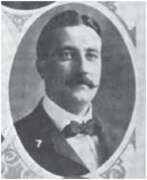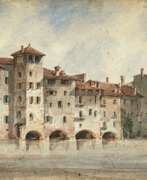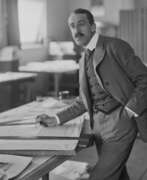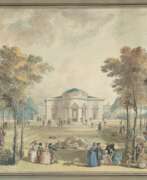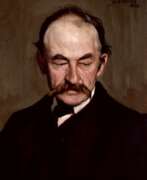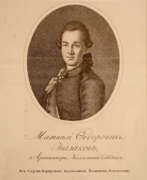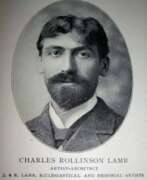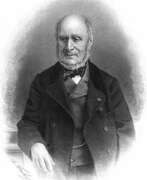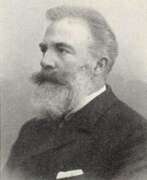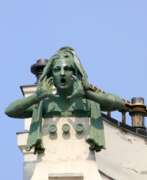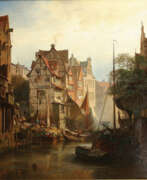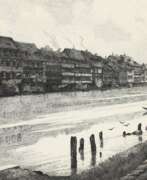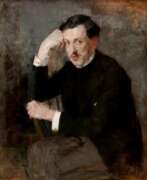Architects 19th century


Antônio Francisco Lisboa, known as Aleijadinho, was a renowned sculptor, carver, and architect in Colonial Brazil. His exceptional works adorned numerous churches across the country, showcasing a style influenced by Baroque and Rococo. Considered the greatest exponent of colonial art in Brazil, Aleijadinho is recognized internationally as a leading figure in Baroque art in the Americas.
Despite limited biographical information, his contributions are celebrated through the vast body of work he left behind. His creations, including carvings, architectural projects, reliefs, and statues, were concentrated in Minas Gerais, notably in Ouro Preto, Sabará, São João del-Rei, and Congonhas. The Church of Saint Francis of Assisi in Ouro Preto and the Sanctuary of Bom Jesus of Matosinhos showcase some of his most significant works.


Erik Gunnar Asplund was a Swedish architect, mostly known as a key representative of Nordic Classicism of the 1920s, and during the last decade of his life as a major proponent of the modernist style which made its breakthrough in Sweden at the Stockholm International Exhibition (1930). Asplund was professor of architecture at the Royal Institute of Technology from 1931. His appointment was marked by a lecture, later published under the title "Our architectonic concept of space." The Woodland Crematorium at Stockholm South Cemetery (1935-1940) is considered his finest work and one of the masterpieces of modern architecture.


Alphonse Balat, full name Alphonse Hubert François Balat, was a Belgian architect.
He studied at the Academy of Namur and earned an architect's degree from the Academy of Antwerp in 1838. Balat's neo-Renaissance work soon came to the attention of the high nobility of Brussels, and he began to receive prestigious commissions.
In 1856, he built the city palace (Hotel) of the Marquis of Asch. After Leopold II ascended to the throne in 1865, Balat became his chief architect. He designed a number of projects for the luxurious reception areas of the Royal Palace of Belgium, such as the Throne Room, the Grand Staircase and the Grand Gallery. Alphonse Balat's most successful architectural project is considered to be the Lacuna Royal Greenhouses, where he pioneered the use of floral motifs, which later became the basis of the Art Nouveau style.
Alphonse Balat also built a large number of private residences during his career.


Peter Behrens was a seminal figure in modern design and architecture, heralded as the first industrial designer and a pioneer in modernist architecture. Born in Hamburg, Germany, Behrens's influence spanned across various domains, including architecture, industrial design, and graphic design. His holistic design approach was revolutionary, encompassing everything from architectural projects to corporate identities.
Behrens's association with AEG (Allgemeine Elektrizitäts-Gesellschaft) marked a significant chapter in his career. Hired as an artistic consultant in 1907, he crafted a comprehensive corporate identity for AEG, including the iconic AEG Turbine Factory (1909), a hallmark of industrial classicism and modernism. This work is celebrated for its pioneering approach to industrial architecture and design, integrating form and function with unprecedented clarity and coherence.
His architectural ventures displayed a versatility and an evolution of style, from the monumental, stripped classical form seen in the German Embassy in St Petersburg (1912) and the Administration Building for Continental AG in Hannover (1912-1914), to the expressive Brick Expressionism of the Technical Administration Building of Hoechst AG in Frankfurt (1920-1924). Behrens's work in the 1920s, including the design for the 'New Ways' house in Northampton, UK, and contributions to the Weissenhof Estate in Stuttgart, underscored his shift towards New Objectivity and modernist principles.
Moreover, Behrens's educational contributions were profound, with his teaching stints at the Academy of Fine Arts Vienna influencing a new generation of architects, including luminaries such as Ludwig Mies van der Rohe, Le Corbusier, and Walter Gropius, who would themselves go on to define the course of 20th-century architecture.
Behrens's legacy is a testament to the transformative power of design, illustrating how integrated and forward-thinking approaches can redefine our built environment and the objects we use daily. His work remains an essential study for collectors, experts in art and antiques, and anyone interested in the evolution of modern design and architecture.
For updates on exhibitions and auctions featuring Peter Behrens's work, sign up for our newsletter. Stay informed about new discoveries, sales, and events related to this pivotal figure in modern architecture and design.




Ignatius Bonomi was an English architect and surveyor.
Ignatius Bonomi was Inspector of Bridges in County Durham, and his work included Skerne Bridge; one of the first railway bridges in Britain over the River Skerne, near Darlington for the Stockton and Darlington Railway in 1824 (hence he is sometimes referred to as "the first railway architect"). He was also responsible for a number of church buildings, historic buildings in the Gothic and Neoclassical styles.


Louis Carrogis, better known as Carmontelle was a French artist, garden designer, architect, playwright and inventor.
Carmontelle was of simple origins but versatilely gifted. He wrote several plays and three novels, and created portraits of historical figures. He became famous for his painting of little Mozart at the clavier. In the service of Louis-Philippe I, Duke of Orléans, he was responsible for the theatrical performances for the family as stage designer and stage director.
Carmontelle is the planner and designer of one of the earliest examples of a French landscape garden in Paris, now known as Parc Monceau. In designing the garden, Carmontel rejected many of the fashionable trends in landscape design at the time, drawing inspiration from Japanese pleasure gardens and insisting on incorporating illusion and fantasy.
Carmontelle is also credited as the inventor of animated images. Translucent tape with landscapes depicted on it was slowly rolled from one roll to another against a backdrop of daylight, thus creating the illusion of walking through a garden.


Louis-François Cassas was a distinguished French landscape painter, sculptor, architect, archeologist and antiquary.
Besides his architectural and archaeological drawings and sketches, he drew numerous costumes studies, views and processions, as well as scenes from daily life, plants and animals of all sorts. He also exhibited views of his travels at the "Salons", which were periodic art exhibitions sponsored by the French Académie Royale, in 1804 and 1814, and published Picturesque views of the Principal Sites and Monuments of Greece, of Sicily, and of the Seven Hills of Rome, of which thirty parts had already been published by 1813.
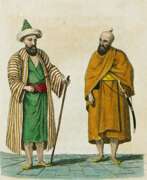

Antoine-Laurent Castellan was a French painter, engraver and architect.
Castellan traveled to Turkey, Greece, Italy and Switzerland. He was the official artist of the mission of Engineer Ferrego to the court of Sultan Selim III, spending several months in Constantinople in 1797. Castellan was a prolific draughtsman, making notes of everything he saw in Constantinople, and also engaged in portrait painting of socialites, which he captured in numerous works he published on his return to France. His best-known work is The Manners, Customs and Costumes of the Otomans and a Brief Account of their History, published in 1812.


Giannino Castiglioni was an Italian sculptor and medallist. He worked mostly in monumental and funerary sculpture; his style was representational, and far from the modernist and avant-garde trends of the early twentieth century.


Charles-Louis Clérisseau was a French architect, draughtsman, antiquary, and artist who became a leading authority on ancient Roman architecture and Roman ruins in Italy and France. With his influence extending to Russia, England, and the United States, and clients including Catherine the Great and Thomas Jefferson, Clérisseau played a key role in the genesis of neoclassical architecture during the second half of the 18th century.


Prince Grigorii Grigorevich Gagarin (russian: Григорий Григорьевич Гагарин) was a Russian painter, illustrator, art researcher, and architect.
He was born into the family of a diplomat, Prince Grigorii Ivanovich Gagarin (1782-1837), who was soon sent to Italy to fulfill the duties of ambassador. Gagarin's house in Rome was the center of cultural life of the Russian diaspora, Alexander and Karl Brullov, Bruni, Shchedrin, Basin, Galberg were regular guests there.
Grigorii early showed a talent for painting, he took lessons from Brullov, after trips to the East he became fascinated by the art of Byzantium. Later, during his service in the Caucasus, he painted in this style the Sion Cathedral in Tiflis. Gagarin also successfully illustrated works of Russian writers, including Pushkin's poem "Ruslan and Lyudmila" and "The Tale of Tsar Saltan", in 1845 he published in Paris an album "Costumes of the peoples of the Caucasus" of 66 hand-colored lithographs.
In 1841 Gagarin was enlisted in the military service and participated in campaigns in the Caucasus. In addition to military duties, he worked a lot for the needs of the Caucasian cities. In Tiflis on his project was built a theater, he restored frescoes in the Sion Cathedral and in old Georgian monasteries.
In Russia, Gagarin's social circle included Zhukovsky, Pushkin, Odoyevsky. Grigorii Gagarin did a lot as vice-president of the Imperial Academy of Arts (1859-1872), trying to reform it in the spirit of the time, founded the Museum of Antiquities. In 1880, Gagarin was made an obra gofmeister of the court of His Imperial Majesty.


Eugène Gaillard was a French art nouveau industrial designer, architect and advocate of modern design. Gaillard abandoned a career in law for that of interior design and decoration. He was employed for some time by Siegfried Bing along with Georges de Feure and Edouard Colonna to work on his pavilion at the 1900 Paris Universal Exposition.


John Gantz was an Austrian-born architect, painter, surveyor and lithographer.
Gantz worked for the East India Company from about 1800 to 1803 as a draftsman and architect. A manuscript list of Madras residents dated March 1819 lists him as "Architect, originally from India". By 1827, Gantz had installed the first lithographic printing press in Madras, one of the first such printing presses in India. Gantz's drawings depict the bridges and architectural structures of the city, the inhabitants in their daily activities, modes of transportation, crafts and professions of Indians, he also painted picturesque landscapes of India.
Gantz had two sons, architect Justinian and Julius.


Hermann Johann Ernst Gemmel was a German architect and artist of the mid-nineteenth century. He is known as an architectural painter and educator.
Hermann Gemmel studied painting at the Berlin Academy of Fine Arts and began to specialize in architectural painting, depicting mainly architectural sites in East Prussia and Italy. These paintings of his are of great historical value today. In 1855 he became professor of perspective and architecture at the Königsberg Academy of Arts.


Aleksandr Mikhailovich Gerasimov (Russian: Алекса́ндр Миха́йлович Гера́симов) was a Russian and Soviet painter, born on August 12, 1881, in Kozlov (now Michurinsk), in the Tambov Governorate of the Russian Empire. He is best recognized for his leading role in promoting socialist realism in visual arts, notably through his portraits of Joseph Stalin and other Soviet leaders. Gerasimov's education at the Moscow School of Painting, Sculpture, and Architecture honed his skills, guided by masters like K.A. Korovin, A.E. Arkhipov, and V.A. Serov. His style, a blend of academic realism with impressionistic influences, vividly depicted the Russian landscape, leaders, and the daily life of the Soviet era.
His works, rich in emotionality and composition mastery, span across various themes from state portraits to landscapes and still lifes, showcasing a deep love for the Russian landscape's innate beauty. Gerasimov's contributions to art include not only significant political portraits but also captivating scenes of nature and life in Russia, marked by their emotional depth and vibrant colors. His paintings like "Stalin and Voroshilov in the Kremlin" won him the Stalin Prize in 1941, cementing his status in Soviet art history.
Gerasimov's artistry extends beyond his political work; his landscapes and portrayals of Russian expanses convey a deep lyrical sentiment, reflecting his profound connection and love for his homeland. His mastery across various mediums—oil, watercolor, gouache, and more—allowed him to explore and express a wide range of subjects, from portraits and landscapes to still lifes, showcasing his versatility and depth as an artist.
For those interested in the intersection of art and history, Aleksandr Mikhailovich Gerasimov's work offers a fascinating window into Soviet-era Russia, its leaders, and its landscapes. To stay updated on exhibitions and sales of Gerasimov's works, sign up for updates specifically focused on new product sales and auction events related to this distinguished artist.


Jules Goury was a 19th-century French architect.
Goury is primarily known for his involvement in the study of the Alhambra Palace with architect Owen Jones. Jones and Goury began studying the palace complex in 1834, but their work was interrupted when Goury died suddenly of cholera. Jones returned to Granada in 1837 to complete his study of the site.
Eventually a book was published on this famous palace, an outstanding monument of Moorish architecture. This sumptuous large-scale publication documents the decoration of the famous citadel palace in Granada, dating mainly from the reigns of the Islamic rulers Yusuf I (1333-1353) and Mohammed V (1353-1391).


Theodor Groll was a German genre painter, landscape and architectural painter.
Theodor Groll was famous for his beautifully detailed architectural drawings. Besides Oswald Achenbach and Albert Flamm, he belongs to the "Italian painters" of the Düsseldorf School.


Walter Adolph Georg Gropius was a German-American architect, recognized as one of the founding masters of modern architecture and the pioneer behind the Bauhaus School. Born in Berlin, Gropius was immersed in an environment that nurtured his architectural interests from an early age, thanks to his well-connected family and architect great-uncle, Martin Gropius. His education took him from Munich to Berlin, where he honed his architectural vision, eventually joining the office of Peter Behrens, where he worked alongside future luminaries such as Ludwig Mies van der Rohe and Le Corbusier.
Gropius's early career saw him co-found an architectural practice with Adolf Meyer, with whom he created the Fagus Factory, a landmark in modern industrial architecture that emphasized the form follows function principle and showcased modernist design through its glass curtain walls. This period was marked by his contributions to the Deutscher Werkbund, advocating for the fusion of art with industrial design, and his leadership at the Bauhaus School, where he fostered an interdisciplinary approach to art and design education.
His relocation to the United States led to significant projects, such as the Harvard Graduate Center and the Josephine M. Hagerty House, marking his influence on American architecture and the broader acceptance of International Modernism. Gropius's legacy is not only in his buildings but also in his philosophy of integrating art, design, and architecture, a vision that continues to inspire architects worldwide.
For those interested in exploring the works and impact of Walter Gropius further, visiting exhibitions at museums or galleries that feature his work and the Bauhaus movement can offer deeper insights. Collectors and experts in art and antiques might find his approach to design and architecture particularly enlightening, given its enduring influence on modern and contemporary art.
If you're captivated by the innovation and ideas of Walter Gropius and wish to stay informed about sales, auctions, or exhibitions related to his work, consider signing up for updates. This subscription will ensure you're always in the know about events and opportunities related to this pioneering figure in modern architecture.


Veronika Maria Herwegen-Manini was a German painter and architect, the daughter of the painter Peter Herwegen (1814-1893). She specialized in architectural painting and is known for her numerous paintings of views of Rome, Venice, and Naples.


Bernhard Hoetger is a German painter, sculptor, graphic artist and architect. He studied at the Dusseldorf Academy of Art.
In 1937, as part of the Nazi "Degenerate Art" campaign, many works by Bernhard Hoetger were destroyed.


Josef Hoffmann, an Austrian architect and designer, is renowned for his influential contributions to early 20th-century design and architecture. As a founding member of the Vienna Secession and the Wiener Werkstätte, Josef Hoffmann's work is celebrated for its pioneering simplicity and functional elegance.
Josef Hoffmann's designs, which span furniture, decorative arts, and architecture, are distinguished by their minimalistic yet expressive style. His ability to blend aesthetics with functionality marked a significant departure from the ornate styles of the time, influencing modern design principles. Notable works include the Stoclet Palace in Brussels, a masterpiece that showcases his innovative approach to art and architecture.
His creations are preserved in prestigious museums worldwide, including the Museum of Modern Art (MoMA) and the Metropolitan Museum of Art, providing insight into his visionary approach to design. These institutions house collections of Hoffmann's furniture and decorative objects, reflecting his enduring impact on design and architecture.
For collectors and experts in art and antiques, Josef Hoffmann's work offers a study in the evolution of modern design. By subscribing to updates, enthusiasts can stay informed about exhibitions, sales, and academic research related to Josef Hoffmann, deepening their understanding of his contributions to the art and design world.




Owen Jones was a British architect, designer, theorist and decorative arts artist.
Educated at the Royal Academy, Jones traveled to the Middle East and Spain between 1833 and 1834, studying the architecture and design of the Islamic and especially the Arab world. Jones dedicated his work Plans, Facades, Sections, and Details of the Alhambra (1842-45) to the famous palace at Granada, an outstanding example of Moorish architecture.
Jones is also known for his work on Eastern and Western design motifs, Grammar of Ornament (1856), which is a systematic pictorial compendium emphasizing the use of color and the application of logical principles in the design of carpets, wallpaper, furniture, and interior decoration.




William Frederick Lake Price was a British painter, watercolorist, lithographer, and one of the first photographers.
Price originally trained as an architect and was an assistant to Augustus Pugin before becoming a watercolorist, photographer, and lithographer. Price knew almost every European language and traveled extensively. The subjects of his paintings were varied, from country house interiors to views of Venice, many are architectural, but there are also literary and historical genre scenes.
From 1828 to 1832 Price exhibited at the Royal Academy, and from 1855 to 1860 he had already exhibited at the Photographic Society of London. In the 1850s he joined the London Photographic Society and the London Photographic Exchange Club. Price staged and directed his first photographs meticulously. He consciously endeavored to elevate the newly emerging photography to the level of "high art," imitating the ambitious literary subjects, expressive gestures, and historical details of great historical painting. In 1858 many of his photographic portraits were published in Portraits of Eminent British Artists.


Oskar Laske was an Austrian architect and painter.
His favourite subjects were watercolours from his travels in Europe and North Africa. They are mostly landscapes, town squares and genre scenes. Laske is also known as a graphic artist and book illustrator.
Oskar Laske was a very prolific artist, and part of his rich legacy is linked to Ukraine and the Ukrainians, especially his hometown of Chernivtsi.


Arsène Lacarrière Latour, full name Géraud Calixte Jean Baptiste Arsène Lacarrière Latour, was a French-born American engineer and military officer, architect and surveyor, and writer.
He studied architecture and engineering at the Académie des Beaux-Arts in Paris and served briefly in the French Army Corps of Engineers. In 1805 Latour came to New York, where he worked first as a merchant, then as an architect and surveyor, and opened an architectural firm in New Orleans. In 1812. Latour became a U.S. citizen.
In 1814. Latour became Andrew Jackson's military engineer and made an important contribution to the American victory at the Battle of New Orleans. After the war ended, Latour published a book, Historical Memoirs of the War in West Florida and Louisiana, 1814-1815, which is still valued for its eye-witness view of the war.
In 1816. Latour traveled with Jean Lafitte on an expedition to survey and map the Southwest as an agent for Spain. From 1818 to 1834 he worked as an architect in Havana. His manuscripts include an extensive report describing Havana's thriving economy in 1815-1821, local agricultural production (sugar cane, coffee, tobacco), trade with Europe, the United States, and the colonies of South America; statistics; and a section on the city's possible future expansion and growth. Latour subsequently returned to France, where he died.


Charles Rennie Mackintosh was a prominent Scottish artist, architect and designer who had a major influence on the development of modernism and global art in the early twentieth century. He was the founder and head of the Glasgow School of Art.
Charles Rennie Mackintosh's style was unique and recognisable. He created elegant and harmonious works reflecting influences from Japanese art, the Gothic style and abstract forms. His works included architectural designs, furniture, paintings, graphics and even decorative objects.
Mackintosh became known for his innovative approach to architecture and design. His buildings were characterised by their refined lines, geometric shapes and use of light and space. His work was an important contribution to the development of modernism and functionalism in architecture.
He was also famous for his ability to combine different materials and textures to create unique and aesthetically pleasing designs. Mackintosh was a master of minimalism and elegance, giving his works a unique style and character.


Emil Maetzel was a German architect, painter, graphic artist and sculptor.
In 1919, Maetzel was a co-founder of the Hamburg Secession, an organisation promoting modern art in northern Germany. He was also a member of the November Group, an association of expressionist artists in Berlin.


Sergey Vasilyevich Malyutin (Russian: Сергей Васильевич Малютин) was a distinguished Russian painter, architect, and designer, celebrated for his multifaceted contributions to the world of art and design. Born in Moscow in 1859 to a merchant family, Malyutin's artistic journey began after an exhibition by the Peredvizhniki inspired him to pursue art. His formal education at the Moscow School of Painting, Sculpture and Architecture honed his talents, leading to a diverse career that spanned painting, set design for operas and ballets, and architectural endeavors.
Malyutin is perhaps best known internationally for designing the first matryoshka doll in 1890, a seminal work that has become an iconic symbol of Russian culture. His involvement in the Arts and Crafts Movement influenced his work, integrating traditional Russian folk motifs into his designs and paintings. Notably, his architectural designs, including the Church of the Holy Spirit in Talashkino and the Pertsov House in Moscow, showcase his dedication to the Russian Revival movement, blending fantastic folk motifs with architectural creativity.
Throughout his career, Malyutin also played a significant role in education, teaching at the Moscow School of Painting, Sculpture and Architecture and advocating for Socialist Realism. His contributions to Russian art were not limited to his creations; he was instrumental in founding the Association of Artists of Revolutionary Russia, emphasizing the importance of art in societal development.
For those interested in exploring the legacy of Sergey Malyutin, his works offer a window into the fusion of traditional Russian art with the innovative currents of his time. Collectors and experts in art and antiques will find his contributions to Russian arts and crafts, especially his role in the creation of the matryoshka doll, to be of particular interest.
To stay updated on exhibitions and auction events featuring Sergey Vasilyevich Malyutin's work, sign up for updates. This subscription is an invaluable resource for enthusiasts looking to deepen their understanding of Malyutin's impact on Russian art and design.


Carl Nebel was a German painter of the mid-nineteenth century. He is known as an architect, painter, graphic artist and draftsman.
Nebel became famous for his lithographs depicting various social and ethnic groups in Mexico. In 1836, he published his famous illustrated book in Paris, which included 50 lithographs of his paintings and drawings. In 1851, Nebel contributed to the publication of The War Between the United States and Mexico, which featured his battle drawings from the American-Mexican War.


Bernhard Pankok, full name Bernhard Wilhelm Maria Pankok, was a German painter and graphic artist, designer, applied artist and architect of the Art Nouveau period.
After acquiring skills as a painter and restorer, Bernhard Pankok studied painting at the Düsseldorf Academy of Fine Arts, then in Berlin. In 1892, he began working in Munich in his own painting studio, doing illustrations for the magazines Pan and Jugend, among others. Pancock was one of the founders of the Munich Association of Art Craft Workshops.
In 1897, Pankok began designing furniture and exhibited his work at numerous exhibitions, including the landmark 1900 "Universal and International Exposition" in Paris. In the same year the art historian Konrad Lange commissioned Bernhard Pancock to design the Haus Lange for him; he worked extensively as an architect in general and designed other buildings in Stuttgart. Pankok was prolific and versatile: he designed sets for opera stages and salons for ocean liners and even the passenger cabins of zeppelins, worked as an architect, furniture designer, interior decorator, painter and graphic artist.
In 1907, he co-founded the Deutsche Werkbund. In 1901 he was invited to teach at the Royal Training and Experimental Workshop in Stuttgart; in 1913 he became its head and in that capacity merged it with the School of Arts and Crafts.


Hans Poelzig was a German architect, whose profound influence on art and culture was marked by his expressive and dramatic architectural style. His work, synonymous with the German Expressionist movement, forged a legacy of emotional and thought-provoking design that continues to resonate with art collectors and experts today.
Among Poelzig's most revered projects is the iconic I.G. Farben Building in Frankfurt, completed in 1931 and now part of Goethe University, a testament to his ability to design on a grand scale. His impact on architectural culture is also seen in the Grosses Schauspielhaus in Berlin, which stands as a paragon of expressionist architecture. This building, along with others like the Four Domes Pavilion in Wrocław, highlights Poelzig's penchant for theatrical and impactful design.
Poelzig's architectural narrative extended beyond the tangible; he conceptualized designs for the Palace of the Soviets and the League of Nations headquarters, which, despite remaining unbuilt, underscore the breadth of his vision. His academic roles, including director positions at the Breslau Art Academy and the Technical Academy in Berlin, allowed him to shape future architects and propagate his innovative design philosophy.
For those deeply invested in the realms of art and antiques, Poelzig’s creations are not merely structures but embodiments of a transformative era in architectural history. His buildings, some of which have earned the honor of being UNESCO World Heritage Sites, serve as a bridge between the past and present of architectural excellence.
To receive updates on new product sales and auction events related to Hans Poelzig, please sign up for our newsletter. This service is exclusively crafted for connoisseurs and professionals, offering timely information to enhance your collection and knowledge of historic art and architecture.


Cyril Edward Power was an English artist best known for his linocut prints, long-standing artistic partnership with artist Sybil Andrews and for co-founding the Grosvenor School of Modern Art in London in 1925. He was also a successful architect and teacher.


Johann Dominicus Quaglio was an Italian-born German painter of the first half of the 19th century. He is known as an architectural painter and graphic artist of the Romantic era, theater artist, lithographer and printmaker.
Quaglio traveled to various countries, which became a source of inspiration for his many works. He depicted medieval churches, castles, ruins and cities in his works. The master was one of the first to use lithography to recreate Gothic structures in graphic form. His works are historical and architectural documents of the time.
Quaglio was court painter to the Bavarian throne and a member of the Munich and Berlin Academies of Arts. He is considered by critics to have brought architectural painting back to a respectable level.


Richard Riemerschmid was a German architect, painter, designer and city planner from Munich. He was a major figure in Jugendstil, the German form of Art Nouveau, and a founder of architecture in the style. A founder member of both the Vereinigte Werkstätte für Kunst im Handwerk (United Workshops for Art in Handcrafts) and the Deutscher Werkbund and the director of art and design institutions in Munich and Cologne, he prized craftsmanship but also pioneered machine production of artistically designed objects.


Alessandro Sanquirico was an Italian painter, scenographer, set designer and architect.
Sanquirico began his work as a decorator for festive celebrations in Milan. In addition to scenography, Sancuirico studied architecture and perspective with Giuseppe Piermarini, architect of the La Scala opera house. Between 1817 and 1832, Sanquirico was La Scala's chief scenic designer and skillfully used the neoclassical architectural style in his sets, as well as images of exotic locations. The scenography created by Sanquirico for La Scala reached a higher level than contemporary designs for opera houses in any other European country. For 15 years he was the sole scenographer, designing sets for productions of operas by Donizetti, Rossini, Bellini, Mozart, Meyerbeer and Pacini. In total, Sanquirico designed more than 300 productions for this theater, including many premieres.
Sanquirico also created several large-scale paintings of historical subjects, worked on the interior of Milan Cathedral and fulfilled other commissions from wealthy nobles.


Thomas Ralph Spence was a British architect, painter and sculptor.
Following a family tradition, Spence began his education as an architect, but later excelled in painting, stained glass and metalwork. In 1885 he moved to London, where he became a successful architectural decorator, responsible for decorative painting at Manchester Cathedral. His largest project was St. George's Church in Jesmond, commissioned by Mitchell Senior, it is considered Spence's greatest architectural triumph.
Spence was highly respected as a decorative artist and designer, his stained glass, metalwork and architectural designs were much admired. In 1896 he co-founded the Society of Designers.
Many of Spence's paintings are inspired by the mythology and classical history of Rome, the time of the Punic War. They include scenes of both domestic life and historical events with many participants. He has exhibited with consistent success at the Royal Academy since 1876.


Gustav Stickley was an American furniture designer, architect, and leader of the American Arts and Crafts movement. He is renowned for his contribution to the design and production of high-quality, handcrafted furniture that emphasized simplicity, functionality, and craftsmanship.
In 1898, he established his own furniture company called the Gustav Stickley Company, later known as Craftsman Workshops. Stickley's furniture designs became synonymous with the Craftsman style, which advocated for well-crafted, and functional pieces.
One of Stickley's most iconic furniture designs was the Morris chair, which became synonymous with the Craftsman movement. The Morris chair featured a reclining back, adjustable angles, and typically incorporated cushioned upholstery.
Stickley's furniture designs were characterized by sturdy construction, visible joinery, and the use of native American woods. He emphasized the beauty of natural materials and the integrity of the craftsman's handwork. Stickley's designs were a reaction against the ornate and mass-produced furniture of the time, and he sought to bring back traditional craftsmanship and simplicity.




